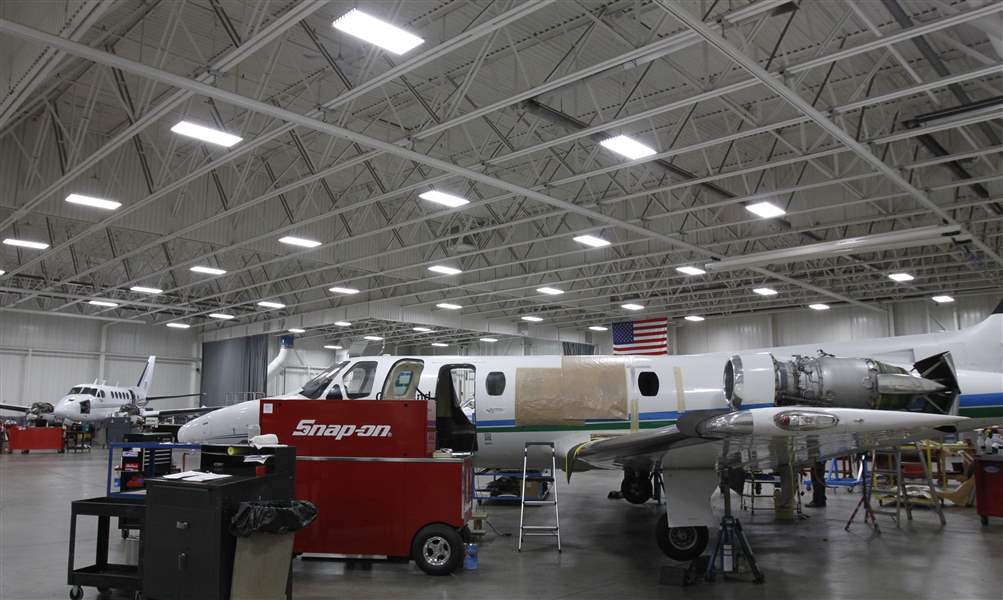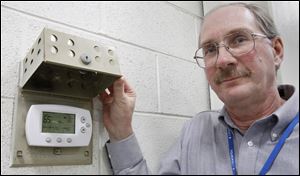
Pilot site saves on energy costs
1/9/2012
The number of overhead lights was reduced at the Toledo Jet Center, but the hangars where staff work on aircraft are just as bright, officials at the facility on the grounds of Toledo Express report.
THE BLADE/LORI KING
Buy This Image

Bill Pribe of Toledo Jet Center shows off one of the six digital thermostats installed in the hangar at Toledo Express Airport as part of its efficiency upgrades.
Bill Pribe isn't quite sure how much Toledo Jet Center is saving on its electricity bill, but he sees that, despite a reduction in the number of fixtures, the hangars where Toledo Jet staff work on aircraft are just as bright as they were before the company replaced its lights.
"When you're working on airplanes, you need a bright light," Mr. Pribe said. "The hangar is very bright, and there's more uniform lighting. It's a better color too: more blue than orange."
Toledo Jet Center, which is at Toledo Express Airport, last year became the first of what the Toledo-Lucas County Port Authority expects to be many private and public building owners in the Toledo area to participate in its Better Buildings Northwest Ohio program. The program is managed by its Toledo Advanced Energy Corporation.
The program's goal is boosting energy efficiency in the Toledo area while simultaneously saving Toledoans money on their lighting, heating, and air-conditioning bills.
"It's easy to find 20 percent or greater savings" from replacing light fixtures, control systems, furnaces, and chillers, said Kevin Moyer, a Perrysburg-based consultant who is overseeing the program for the port authority. Utility-cost reductions of 30 to 50 percent are not uncommon, he said.
A $15 million federal grant the port authority received last year is the seed for a loan program officials expect will ultimately finance more than $300 million worth of energy efficiency improvements for residential, commercial, industrial, and government buildings in Toledo and surrounding areas.
The port authority expects to issue about $50 million in bonds to supplement the federal funds, including a $10 million bond issue the board of directors approved Dec. 15 and plans for sale in mid-March.
The bonded debt will be repaid from the proceeds of special assessments on the improved buildings -- assessments the buildings' owners are presumably able to pay with the savings from their lower utility bills. The assessments are calculated before work begins, said Markus Rasmus, the program's transaction manager.
Mr. Pribe said he can't come up with an actual savings figure because Toledo Jet's energy improvements, which also included replacing thermostats and other efficiency upgrades, coincided with an increase in the company's work force and working hours, so a true comparison is impossible.
The pending $10 million bond sale is specifically for long-term financing of the city of Toledo's Collins Park Solar Project and energy-efficiency improvements for about 30 city-owned buildings.
The 30 Toledo buildings include 19 firehouses, four senior citizens' centers, and several police stations and community centers, Mr. Moyer said.
"This is going to save the city of Toledo a lot of money, as well as make employees more comfortable," he said.
The city of Oregon is also among the entities planning for program-related work early in 2012.
"Our objective is lowering the operating costs of our buildings," city Administrator Mike Beazley said, noting that many city facilities "were pieced together over time."

The number of overhead lights was reduced at the Toledo Jet Center, but the hangars where staff work on aircraft are just as bright, officials at the facility on the grounds of Toledo Express report.
Officials expect to choose projects over the next few months so that they can be done in the spring, between the peaks of the heating and cooling seasons, he said.
"We've got a $26 million pipeline of projects that are in various stages" of preparation or construction, Mr. Moyer said.
Port authority President Paul Toth said the agency's involvement in the Advanced Energy Utility program started with "us looking at ourselves."
Replacing lighting fixtures in the port authority's administrative offices would cut utility costs an estimated 25 percent, Mr. Toth said, and port officials are striving to persuade the building's owners to enter the program. The port authority realized significant savings when it replaced boilers at Martin Luther King, Jr. Plaza after buying the train station in 1994, he said.
Mr. Toth added that he "did some upgrades" on his own home, which is just 20 years old.
"My electricity bills have been running 40 to 60 percent less than they were a year ago," the port president said, adding that he also got manufacturer rebates and tax credits worth more than $10,000 on the equipment.
But many homeowners and businesses hesitate to replace furnaces or air conditioners until they fail, Mr. Moyer said, primarily because the capital cost is daunting and the savings seem less certain than the bills they currently pay.
Eventually, he said, the port authority's program could include financing for single-family residences, though for now that's not available.
"We are going to make a big push into the small commercial market early next year," he said.
The process starts with energy assessments that, along with efficiency, also consider the age and likely maintenance needs for a building's equipment, Mr. Moyer and Mr. Rasmus said.
Not only will replacing an old "chiller" unit at the Louisville Title building in downtown Toledo cut that company's air-conditioning cost by 20 percent, Mr. Rasmus said, it will eliminate a $10,000 annual maintenance cost.
"People that have equipment that's toward the end of its useful life, while they're replacing that, they can do the other work and get it all done," he said.
Replacement of the air-conditioning system at the Valentine Theatre, Mr. Moyer told port directors last month, will cost $110,000 but will save the theater so much on its electricity bill it will be able to have shows in the summertime.
Until now, he said, "it cost too much for them to power up the cooling system in the summer."
Mr. Toth said three companies are performing the energy assessments for the port authority program.
Afterward, they can write specifications for replacement equipment and fixtures, and building owners may either hire their own contractor or select one recommended by Better Buildings.
Bernard "Pete" Culp, a port authority director, complained during the Dec. 15 board meeting that minority contractor participation in the 35 projects now under way through the program was inadequate.
Mr. Toth responded that although five qualified minority contractors attended a conference before the bidding and the 35 buildings were advertised as individual contracts to give small firms a better shot at getting some of the work, none of them submitted bids.
"It would have been a whole lot easier if we just bid that as one big project," the port president said.
Mr. Culp said the agency needs to do better in that regard in the future.
"We do a good job of telling other people how to bring in minorities, but I'm not sure we're doing it here," he said.
Business owners interested in arranging for energy assessments of their buildings may obtain more information about the program by visiting the Better Buildings NWO page on the toledoportauthority.org Web site or by calling 419-720-1102.
Contact David Patch at: dpatch@theblade.com or 419-724-6094.